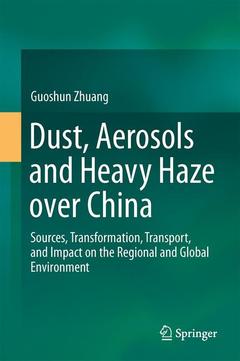Preface: Aerosol, Dust, Haze, and Global Biogeochemical Cycle
Part I
Characteristics and sources of atmospheric aerosols over the typical regions of China
Chapter 1 Atmospheric aerosol and its potential impact on the regional/global environment and climate change.
Chapter 2 large scale distribution of atmospheric aerosol in China
Chapter 3 Air-borne particulate pollution in Beijing − concentration, composition, distribution and sources
Chapter 4 Ion chemistry and the source of PM2.5 aerosol in Beijing
Chapter 5 Characteristics of carbonaceous species and their sources in PM2.5 in Beijing,
Chapter 6 Characteristics of re-suspended road dust and its impact on the atmospheric environment in Beijing
Chapter 7 Air pollution caused by the burning of fireworks during the lantern festival in Beijing
Chapter 8 Air
quality over the Yangtze River Delta during the 2010 Shanghai Expo
Chapter 9 Ion chemistry, seasonal variation and source of PM2.5 and TSP in Shanghai
Chapter 10 Sources and seasonal variations of organic compounds in PM2.5 in Beijing and Shanghai
Chapter 11 The most serious air-pollution in the edge of the dust source area – Urumqi, Xinjinag, China
Chapter 12 Chemical Characterization of Aerosols at the Summit of Mountain Tai in Central-eastern China
Chapter 13 Aerosols over Yulin, the north edge of Loess Plateau, Mixing of dust with pollution on the transport path of Asian dust
Chapter 14 Characteristics of dust aerosols over Taklimakan Desert and its impact on the global change
Chapter 15 Characteristics of dust aerosols over Inner Mongolia Gobi, one of the two major source regions of Asian dust storm
Chapter 16 Characteristics and sources of atmosphe
ric aerosols over Hotan, the region of the Severest Dust Storm in China
Part II
Formation mechanism and sources of heavy haze-fog over the typical regions of China
Chapter 17 Chemical Characteristics of PM2.5 and PM10 in Haze-fog Episodes in Beijing,
Chapter 18 Relation between optical and chemical properties of dust aerosol over Beijing
Chapter 19 Formation mechanism of the heaviest pollution episode ever recorded in the Yangtze River Delta, China.
Chapter 20 Sources and characteristics of a heavy dust pollution event in Shanghai
Chapter 21 A multi-years evolution of aerosol chemistry impacting visibility and haze formation over an Eastern Asia megacity, Shanghai
Chapter 22 Chemistry of heavy haze over Urumqi, central Asia
Chapter 23 Impact of anthropogenic emission on air quality over a megacity
C
hapter 24 How to improve the air quality over megacities in China: Traffic sources to be one of the major sources triggering the heavy haze
Chapter 25 Extreme haze pollution over northern China in January, 2013: chemical characteristics, formation mechanism and role of fog processing
Chapter 26 Probing the severe haze pollution in three typical regions of China: characteristics, sources and regional impacts
Chapter 27 Evolution of particulate sulfate and nitrate along the Asian dust pathway: secondary transformation and primary pollutants via long-range transport
Chapter 28 Aerosol oxalate and its implication to haze pollution in Shanghai, China
Chapter 29 Implication of carbonaceous aerosol to the formation of haze---Revealed from the characteristics and sources of OC/EC over a megacity in China
Part III
Aerosol and Acid Rain
Chapter 3
0 Chemistry of precipitation and its relation to aerosol in Beijing
Chapter 31 Chemistry of the severe acidic precipitation in Shanghai, China
Part IV
Mixing mechanism of dust with pollutant aerosol during the long-range transport
Chapter 32 Compositions, sources, and size distribution of the dust storm from China in spring of 2000 and its impact on the global environment
Chapter 33 Characteristics and sources of 2002 super dust storm in Beijing
Chapter 34 Composition and mixing of individual particles in dust and non-dust conditions of north China, spring 2002
Chapter 35 Variation of sources and mixing mechanism of mineral dust with pollution aerosol in a super dust storm —revealed by the two peaks of a super dust storm in Beijing
Chapter 36 Chemical composition of dust storms in Beijing and implications for the mix
ing of mineral aerosol with pollution aerosol on the pathway
Chapter 37 Variation of characteristics and formation mechanisms of aerosols in dust, haze, and clear days in Beijing
Chapter 38 Asian dust over northern China and its impact on the downstream aerosol chemistry in 2004
Chapter 39 Evolution of chemical components of aerosols at five monitoring sites of China during dust storms
Chapter 40 Characterization and Source of Polycyclic Aromatic Hydrocarbons and Fatty Acids in PM2.5 in Dust Episodes in China
Chapter 41 Heterogeneous Reactions of Sulfur Dioxide on Typical Mineral Particles
Chapter 42 Transport and mixing of dust aerosols and pollutants during an Asian dust storm in March 2002
Chapter 43 Water-soluble part of the aerosol in the dust storm season——Evidence of the mixing between mineral and pollution aerosols
Chapter 44 Mineral aerosol and
its impact on urban pollution aerosols over Beijing, China
Chapter 45 Mixing of mineral with pollution aerosols in dust season in Beijing: Revealed by source apportionment study
Chapter 46 Characterization of aerosol over the Northern South China Sea during two cruises in 2003
Chapter 47 Mixing and transformation of Asian dust with pollution in the two dust storms over the northern China in 2006
Chapter 48 mixing of Asian dust with pollution aerosol and the transformation of aerosol components during the dust storm over China in spring, 2007
Chapter 49 Mixing of Asian mineral dust with anthropogenic pollutants and its impact on regional atmospheric environmental and oceanic biogeochemical cycles over East Asia: a model case study of a super-dust storm in March 2010,
Chapter 50 Aerosol Particles from Dried Salt-Lakes and Saline Soils Carried on Dust Storms
Chapter 51 Cou
pling and Feedback Between Iron and Sulphur in Air-Sea Exchange
Chapter 52 Speciation of the elements and composition on the surface of dust storm particles—Evidence for the coupling of iron with sulfur in the aerosol during the long-range transport





